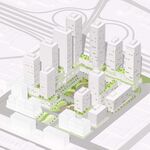Electrifying the GO network would be the best thing for Transit City, because it would eliminate a lot of the need for it to balance local demands with long-haul demands, because the long-haul would be carried by GO.
The LRT lines would then be free to act as they do in almost every other large city in the world: as feeder lines, and as lines that 'connect the dots' or 'fill the gaps' left in the primary network's layout.
And I challenge the idea that electrifying GO service (which I think should be referred to as GO-REX (Regional Express), which just sounds cool) wouldn't significantly benefit the core. On the contrary, it would be the best thing for the core. It would be better than building the DRL in fact, because you would get a multitude of different options. Dundas West-Bloor Station would have 2 GO-REX lines and a subway line serving it. Liberty Village Station would have 3 GO-REX lines and a major streetcar line. Main-Danforth Station would have 2 GO-REX lines, a subway line, and a streetcar line.
These have the potential to be major hubs, especially if a few bus routes are rerouted to them. A bus that ends up at Dundas West station, the rider has 4 options for getting downtown. The combined frequency on the GO-REX at Dundas West-Bloor would be around 5 minutes, given that the two lines (Milton and Georgetown) would each be running about 10 minute frequencies. That's as good as a subway, and they both go much further out than a DRL ever would.
Consider that each of these GO-REX lines has the potential to carry between 15,000 and 20,000 pphpd during peak, and that $4 billion suddenly becomes a wiser investment than a couple LRT lines lines whos combined ridership wouldn't even total one of those GO-REX lines.
The LRT lines would then be free to act as they do in almost every other large city in the world: as feeder lines, and as lines that 'connect the dots' or 'fill the gaps' left in the primary network's layout.
And I challenge the idea that electrifying GO service (which I think should be referred to as GO-REX (Regional Express), which just sounds cool) wouldn't significantly benefit the core. On the contrary, it would be the best thing for the core. It would be better than building the DRL in fact, because you would get a multitude of different options. Dundas West-Bloor Station would have 2 GO-REX lines and a subway line serving it. Liberty Village Station would have 3 GO-REX lines and a major streetcar line. Main-Danforth Station would have 2 GO-REX lines, a subway line, and a streetcar line.
These have the potential to be major hubs, especially if a few bus routes are rerouted to them. A bus that ends up at Dundas West station, the rider has 4 options for getting downtown. The combined frequency on the GO-REX at Dundas West-Bloor would be around 5 minutes, given that the two lines (Milton and Georgetown) would each be running about 10 minute frequencies. That's as good as a subway, and they both go much further out than a DRL ever would.
Consider that each of these GO-REX lines has the potential to carry between 15,000 and 20,000 pphpd during peak, and that $4 billion suddenly becomes a wiser investment than a couple LRT lines lines whos combined ridership wouldn't even total one of those GO-REX lines.




